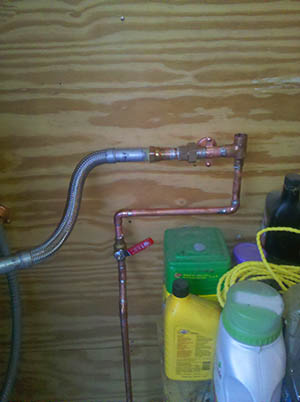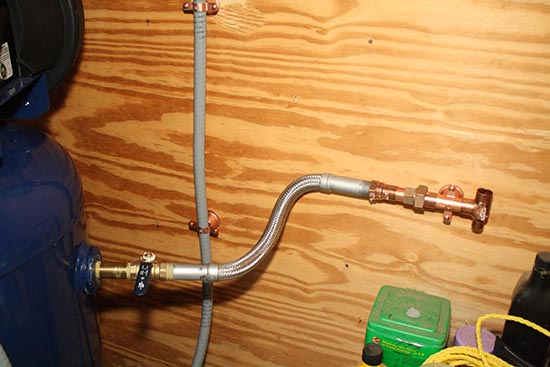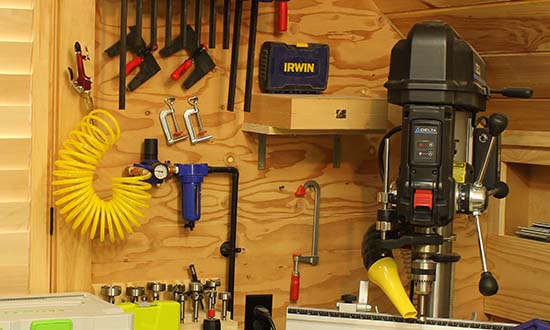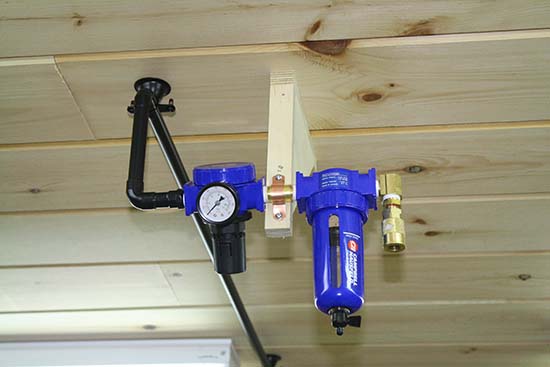Workshop Compressed Air
Compressed Air System for Workshop and Garage
 Having a functional, well designed compressed air system is very versatile for any woodworking shop and garage. My woodworking shop is located on the second floor above my garage so I designed a system that would easily serve both locations and the tasks that I do in each.
Having a functional, well designed compressed air system is very versatile for any woodworking shop and garage. My woodworking shop is located on the second floor above my garage so I designed a system that would easily serve both locations and the tasks that I do in each.
I installed a Campbell Hausfeld 60 gallon air compressor in the corner of my garage nearest the overhead door and the furthest possible from my house. The compressor is bolted to the concrete slab to prevent it from moving due to vibration.
Features & Specifications
- Motor: 3 HP Marathon Electric
- Voltage: 240 V
- Weight: 353 lbs
- Heavy duty CAST IRON oil lubricated twin cylinder pump
Note: You’ll need to supply your own wiring harness from the motor to a disconnect.
Air Supply System
The compressor is the easy part of the system, the harder part in my opinion is delivering the air around the shop. For me there were several issues to consider including: Safety, Clean Air and Easy Access. For my system I used copper piping soldered together. I realize some people try to use PVC as it’s cheaper and easier to assemble but I’m not a fan of that idea due to safety concerns. PVC is a brittle material that could cause serious injury if it were to break. Another option would be cast-iron but that’s not something I have the skill to do so I went with the copper option.
 The first step in my system is a tank shut off valve right at the tank followed by a flexible braided hose to isolate any vibration from the motor. This is pretty important unless you want to fix leaks in the piping due to vibration. You can find these braided hoses used for hydraulic pressure lines.
The first step in my system is a tank shut off valve right at the tank followed by a flexible braided hose to isolate any vibration from the motor. This is pretty important unless you want to fix leaks in the piping due to vibration. You can find these braided hoses used for hydraulic pressure lines.
The next important component is a drain to allow you to drain condensate water from the air lines. Over time water will condensate inside the lines and you need a way of getting it out. I created a simple vertical drop of pipe below the first riser with a valve on it. Every month or so I open the valve and let any water out that’s accumulated in the lines.
From this point I soldered together3/4″ copper pipe from this location up to the woodworking shop and also a branch for the garage. Each branch is isolated with valves, however the layout is such that each branch can drain back to the start where I have located the drain.
Before I installed the branch lines I installed a secondary pressure relief valve. While not 100% necessary as the compressor comes with one standard, I wanted an additional level of protection due to the fact that this large compressor is located in the garage where my kids are always coming and going. The relief valve I purchased is slightly higher pressure rated than the tank, but certainly at a pressure much lower than the pipe system which will prevent any possible “disaster” issues.
From the main branches I soldered 1/2″ copper pipe to each terminal location. I have several terminal locations that I’ve set up including two in the woodworking shop.
At each location in the shop I have an air filter and a regulator so I can control the air pressure. It’s really important to use air filters to remove water and oil (if you’re doing any painting or using tools that can be damaged from oil). It’s also important to have a regulator so you can control the air pressure, otherwise you’re at the mercy of whatever pressure is in the tank at any given time. I really like the accessories that Campbell Hausfeld offers including:
- Campbell Hausfeld H7273 Standard Pressure Regulator
- Campbell Hausfeld PA2121 Standard Air Filters
- Campbell Hausfeld PA2085 Clean Air System
I also installed another connection location above the assembly table / tablesaw. This is very convenient when I’m using my brad and pin nailers for assembly work. Located overhead out of the way yet at a height I can easily reach to connect a hose to. Most of the time I keep a short flexible coiled hose connected to a hand air gun. This is a huge help when cleaning up in the shop and it’s what I use the air for most of the time when not using my nailers.














